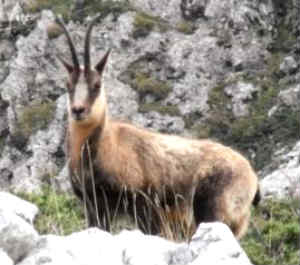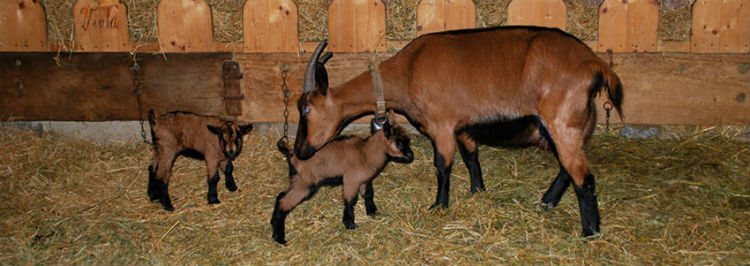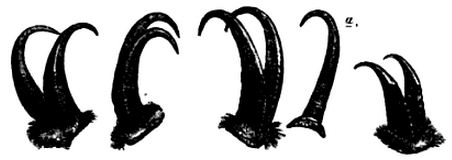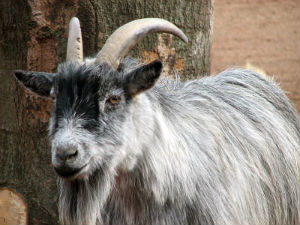Goat-chamois hybrids
Capra hircus × Rupicapra rupicapra
Mammalian Hybrids
|
|
EUGENE M. MCCARTHY, PHD GENETICS
 Chamois
Chamois
For whatever reason, it seems that all reports of this cross date to the 19th and early 20th centuries. One possible explanation is that fewer goats are now kept in the Alpine regions of Europe than formerly. There is, of course, the breed known as the chamois-colored goat, indigenous to Switzerland where chamois are abundant, which bears so many similarities to chamois that it seems likely that it is actually derived from goat-chamois hybrid forebears (see image below).
 The chamois-colored goat, a Swiss breed likely derived from goat-chamois hybrid ancestors.
The chamois-colored goat, a Swiss breed likely derived from goat-chamois hybrid ancestors.
 Horns of putative goat-chamois hybrids.
Horns of putative goat-chamois hybrids.
In the 1800s, this hybrid was frequently mentioned. In the Proceedings of the Zoological Society of London (1869, pp. 134-135) Edward Blyth says the following of the horns pictured above:
Although Blyth mentions a “tame” chamois, reports of this cross generally involve male chamois coming down from the mountains to mate with domestic goats. Ackermann 1898 (pp. 66-67) says, “Several well-known naturalists believe in hybrids between goats and chamois. In his Naturgeschichte [1847], p. 177, Bronn refers to smooth, hook-shaped, back-bent horns, seen by a certain animals in the Schamser Valley (Canton Graubünden, Switzerland), that suggested the offspring of a goat and chamois. According to von Wildungen, hybrids between goat and chamois buck in fact more resemble the sire in form and physical strength and, like the sire, scale the steepest cliffs.
 Domestic goat
Domestic goat
German zoologist Alfred Brehm (Tierleben, vol. 3, p. 275) also deemed this cross possible. “Sometimes it happens,” he says, “that a chamois buck mixes with pasturing goats, wins the attention of a female goat, and mates with her.” According to Ackermann, Bechstein reported a goat- hybrid and Tschudi refers to reliable examples of successful crossing between domestic goat and chamois in a natural setting.
Girtanner (1880, p. 48) says he himself had seen hybrids produced from matings of she-goat and buck chamois, that they occur in both captivity and with wild chamois, and that hybrids of this type easily die shortly after birth but if raised, he says, they are hardy animals.
Mann (1867), who is often cited by later writers on this subject, says that goat-chamois hybrid are born naked due to the shorter gestation period of goats, which is 150 days (that of a chamois is 170). In English translation, Mann states that "For several days here, there have been a pair of
References: Ackermann 1898 (pp. 66-67); Bronn 1847 (p. 167); Girtanner 1880; Gray 1972 (p. 132); Przibram 1910.
Most shared on Macroevolution.net:
Human Origins: Are we hybrids?
On the Origins of New Forms of Life
Mammalian Hybrids
Cat-rabbit Hybrids: Fact or fiction?
Famous Biologists
Dog-cow Hybrids
Georges Cuvier: A Biography
Prothero: A Rebuttal
Branches of Biology
Dog-fox Hybrids